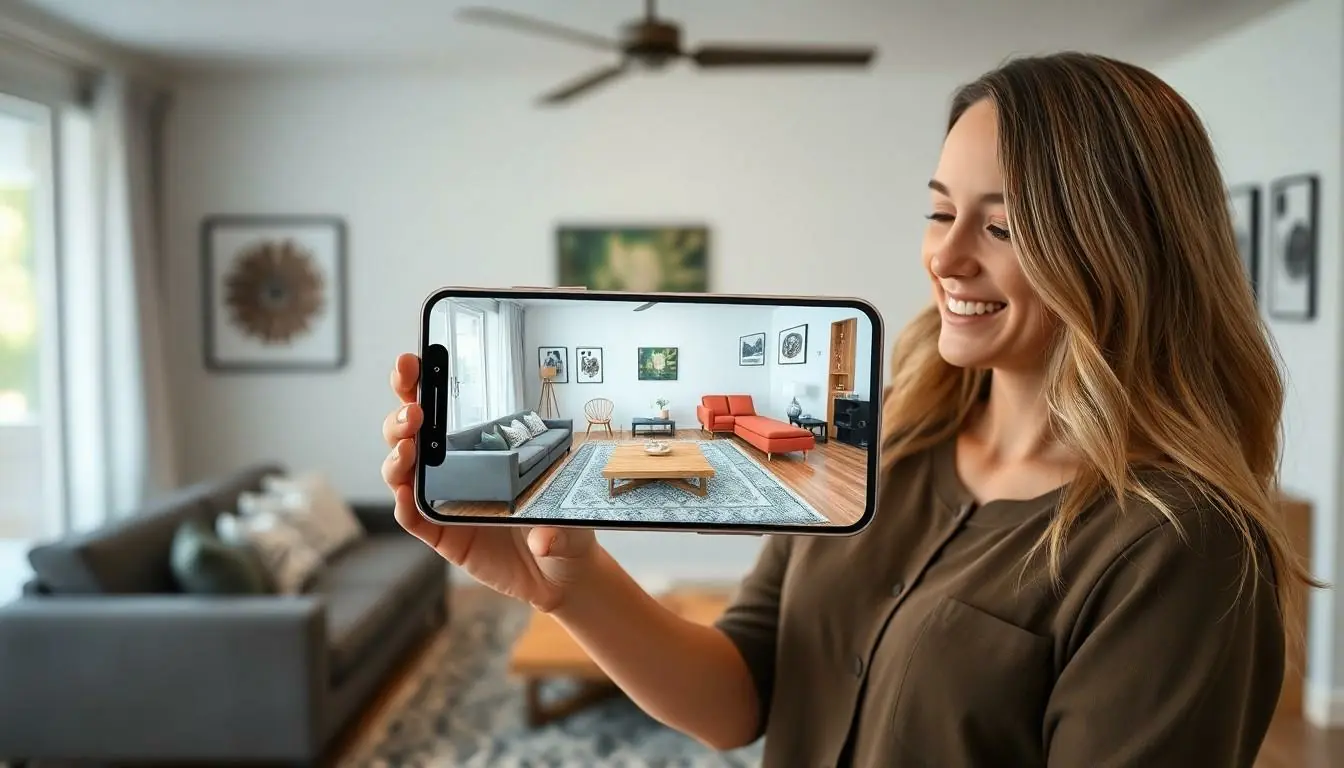Imagine walking through a mall and suddenly a giant animated burger pops up, inviting you to try the latest fast-food sensation. That’s the magic of augmented reality (AR) advertising. This innovative technology transforms the mundane into the extraordinary, allowing brands to engage consumers in ways that are not just memorable but downright fun.
From virtual try-ons that save you from fashion faux pas to interactive experiences that turn product demos into adventures, AR advertising is redefining how brands connect with their audiences. In a world where attention spans are shorter than a TikTok video, AR offers a captivating way to stand out. Buckle up as we explore some of the most creative and effective AR advertising examples that are not only entertaining but also drive results.
Table of Contents
ToggleWhat Is AR Advertising?
AR advertising uses augmented reality technology to create interactive experiences for users. This type of advertising blends digital elements with the real world, enhancing the consumer’s engagement. Brands leverage AR to show products in new and innovative ways, making marketing campaigns more memorable.
Examples include virtual try-ons for clothing or makeup, letting customers visualize how items look before purchase. Additionally, AR can provide interactive advertisements that engage users, prompting them to explore products in a unique manner. This technology also allows consumers to engage with brand stories through immersive content.
Statistics show that AR features increase purchase intent significantly. In a study, 61% of consumers preferred brands that offered AR experiences. Such statistics highlight the importance of integrating AR into marketing strategies for improved consumer connections.
Key benefits of AR advertising include heightened user engagement, improved brand recall, and the ability to demonstrate complex products effectively. Retailers, for instance, can enhance the shopping experience by providing AR-enabled catalogs. Automotive companies also utilize AR to allow potential buyers to visualize vehicles in their environment.
As audiences seek interactive content, AR advertising becomes crucial in distinguishing brands in competitive markets. Businesses, by adopting AR solutions, tap into the growing demand for innovative experiences. Ultimately, AR advertising transforms traditional marketing tactics, pushing boundaries and redefining customer interactions.
Popular AR Advertising Examples

Augmented reality advertising showcases brands embracing innovative strategies to engage consumers. The following examples highlight AR’s potential in enhancing brand visibility and product understanding.
Brand Campaigns
IKEA exemplifies effective brand campaigns using AR technology. The IKEA Place app allows users to visualize furniture in their homes before purchase. Users can see how items fit in real-world spaces, fostering an interactive shopping experience. Pepsi’s “Unbelievable Bus Shelter” campaign also captivated audiences. AR enabled bus shelters to transform into thrilling scenes, surprising waiting passengers and leaving a memorable impression. Brands utilizing these approaches experience increased consumer interaction, with 61% of shoppers preferring AR-enhanced experiences.
Product Demos
Sephora leads with immersive product demos through its Virtual Artist app. Customers can virtually try on makeup products, enhancing their shopping decisions before buying. AR product demos streamline the decision-making process. Examples include L’Oreal’s Makeup Genius app, which allows users to see how different cosmetics look on their own faces. These interactive demos significantly improve user engagement by making product exploration enjoyable and informative. Brands integrating AR demos report greater consumer confidence, driving sales and enhancing overall satisfaction.
Benefits of AR Advertising
AR advertising presents numerous advantages that enhance marketing strategies and consumer experiences. Increased interaction and personalized content create memorable engagements, enticing users to explore brands further.
Enhanced User Engagement
User engagement rises significantly through AR advertising. Brands create immersive experiences that capture attention with interactive elements. For example, virtual try-ons allow customers to visualize products instantly. These personalized experiences foster deeper connections with the brand, increasing time spent on advertisements. Studies show that such interactive content triples the likelihood of shareability on social media. Ultimately, heightened user engagement translates into stronger brand loyalty and improved conversion rates.
Increased Brand Awareness
Brand awareness benefits immensely from AR advertising. Engaging experiences spread quickly, allowing brands to reach broader audiences. Interactive campaigns stand out, prompting users to talk about their experiences within their networks. Companies that utilize AR see up to a 70% increase in brand recall compared to traditional methods. Eye-catching AR ads boost visibility, ensuring consumers remember the brand when making purchase decisions. Consequently, AR advertising becomes a vital tool for brands seeking to elevate their market presence.
Challenges in AR Advertising
AR advertising faces several challenges that can affect its effectiveness and adoption. Understanding these obstacles helps brands strategize effectively.
Technical Limitations
Technical limitations hinder AR advertising potential. Many devices lack the processing power and capabilities to run complex AR applications smoothly, leading to performance issues. Compatibility across various platforms becomes another concern, as not all users have access to the latest technology. Data illustrates that 64% of users experience frustration with lagging or glitchy performances. Furthermore, high development costs can dissuade brands from pursuing AR campaigns. Effective strategies require investment and expertise that not all companies can afford.
User Adaptability
User adaptability presents a significant challenge in AR advertising. Many consumers remain unfamiliar with AR technology and struggle to navigate AR interfaces. Research indicates that 60% of users find it difficult to understand how to interact with AR experiences properly. This lack of knowledge can lead to underutilization of AR applications. Brands need to invest in education and intuitive design to enhance user experiences. Additionally, privacy concerns may deter some users from engaging with AR ads, making consumer trust essential for successful campaigns.
Future Trends in AR Advertising
AR advertising continues to evolve, and several trends are shaping its future. Enhanced personalization stands out as a major trend, enabling brands to tailor experiences to individual user preferences. Companies can leverage AI algorithms to analyze consumer behavior, allowing for hyper-targeted AR campaigns that resonate more deeply.
Increased integration with social media platforms further drives AR advertising. Brands are adopting AR features in apps like Instagram and Snapchat, reaching broader audiences. This integration encourages user-generated content, as consumers share their unique AR experiences directly from these platforms.
Adoption of AR in e-commerce will likely rise significantly. Virtual try-ons and interactive product displays are already transforming the online shopping landscape. Consumers appreciate the experiential component, which improves confidence in their purchase decisions. Recent statistics show that incorporating AR can elevate conversion rates by up to 70% in some cases.
Expanding into augmented reality gaming presents another exciting avenue. Brands are collaborating with game developers to create immersive experiences that blend advertising with entertainment. This strategy enhances user engagement and allows for innovative storytelling.
Moreover, advancements in AR technology contribute to improved user accessibility. Innovations in mobile devices and AR headsets facilitate seamless experiences, taking the user experience to new heights. Research indicates that more intuitive designs can alleviate user hesitation, addressing the 60% of consumers who struggle with existing AR interfaces.
As privacy concerns grow, brand transparency becomes crucial. Companies that prioritize consumer trust and clearly communicate data usage will likely see higher engagement rates. These trends in AR advertising pave the way for a future where immersive brand interactions become a standard in marketing strategies.
The potential of AR advertising is undeniable as it reshapes how brands connect with consumers. By leveraging immersive experiences brands can enhance engagement and foster lasting relationships. As technology continues to evolve the opportunities for creativity and innovation in AR advertising will only expand.
With successful examples from industry leaders showcasing the effectiveness of AR in driving sales and brand loyalty it’s clear that embracing this technology is no longer optional for brands aiming to thrive. As the landscape evolves staying ahead of trends will be crucial for marketers looking to create impactful and memorable interactions with their audiences.

